
As every executive knows, organisations are using the opportunity COVID-19 has brought to advance their business but in particular, their employee experience. In part, this is being driven by the need to adopt new technologies to support remote working but also by the demands employees are placing on those who employ them.
According to the World Economic Forum, organizations will need to reshape their people strategies if they are to survive the ‘Fourth (Industrial) Revolution’.
Although experts describe the Fourth Revolution as a ‘human’ revolution, the challenges companies face will be addressed using digital technologies; albeit they will need to be informed by human-centred science as opposed to antiquated practices that still dominate the market.
Irrespective of history, if you are to be an employer of choice in the new world, it is vital you position this challenge in your business as an opportunity to realise long-term competitive advantage as opposed to a temporary issue you have to address.
To this end, we hope you find this document useful, however, it won't take you forward unless you make a decision to act on it.
Craig Steel – Founder and Chief Executive

Situational overview
The outbreak of COVID-19 has not only disrupted the lives of millions, it has changed business for good. As a result, flexible working and talent management have become a top priority for everyone.
In years gone by, the need for Chief Executives to delve into their people practices was at most intermittent, whereas today, they know this subject will determine their very survival.
The speed at which new technologies are disrupting industry means our competitors in two to three years may not yet even exist.
Further to this, new ways of working mean tomorrow's workforce will be more mobile and informed which will tilt the balance of power.
With over 40 percent of the global workforce considering leaving their employer in the coming year, companies will need to reinvent the way they work if they are to retain the talent they need going forward.
As Microsoft points out in its latest (2021) Work Trend Index Annual Report*, there are seven trends businesses need to understand if they are to remain competitive in the future.
These include the permanence of flexible working, the fact leaders are out of touch with their employees and need to address it, that our historically high productivity levels are masking employee exhaustion, that Gen Z is at risk and needs to be re-energised, that shrinking networks are endangering innovation, that authenticity, when demonstrated, still spurs productivity and engagement and that talent is everywhere and available to those who embrace next-generation practices.
As performance specialists, we are excited about the changes taking place but we are also cognisant of the pressures they are placing on businesses the world over.
Through no fault of their own, we are seeing historically successful companies being thrown into turmoil because they haven’t had the headspace to look around the corner.
Equally, we are seeing organisations that are otherwise unremarkable winning business because they have had the foresight to focus on their people’s experience.
Irrespective of your situation, you need to know what’s coming and how it will affect your sector.
You also need to recognise that conventional management theories are being thrown out faster than at any time in history because they’re in conflict with the new world people want to work in.
While there’s no doubt some industries will have more time to change than others, it is clear every organisation competing in the global market will need to adopt more employee-centric processes if they are to retain the goodwill of their people.
They will also need to think of their people’s experience as the key to winning customers, and champion diversity and inclusion; not only because it’s the right thing to do but because if they don’t,
they’ll get run over by those who embrace it. Further to this, they will need to simplify their business to reduce the stress their staff are experiencing rather than throwing money at wellness programmes and resilience training in an attempt to try and address it.
Most importantly though, leaders need to start thinking about their people as the only sustainable point of difference they’ve got rather than a resource they require to operate.
For those who address these things, they will enjoy a long and prosperous future. However, for those who don’t, they will simply disappear.
Additional considerations
The World Economic Forum’s six imperatives for business leaders*:
- Developing new leadership capabilities
- Managing the integration of technology in the workplace
- Enhancing the employee experience
- Building an agile and personalised learning culture
- Establishing appropriate metrics for valuing human capital
- Embedding diversity and inclusion


Where things are at
Despite continuing growth in the commercial sector, conventional management practices are broken. To prove this, we only need to look at the evidence. For example, why is it that employee engagement (in general) is continuing to fall even though organisations are spending more on their staff than ever before?
Why is it that employees are expressing greater dissatisfaction with their employer all the while they’ve been going out of their way to try and accommodate them?
And why is it that we are seeing relationships between employees and employers becoming ever more fragile even though both are looking for greater substance?
The fact is employers need more from their people to do better. At the same time, employees say they want more meaningful interactions and involvement with their employer.
These findings suggest both parties want the same thing. However, because organisations continue to use outdated practices to manage their people, their relationships are strained leading to a burgeoning gap between ‘them’ and ‘us’.
Sadly, despite genuine attempts by executives in recent years to improve workplace relations, the majority of employees say they feel like ‘just another worker’ (JAW) rather than a ‘valued
member of the team’ (VMT). Further to this, being on the receiving end of compliance-based practices reminds them of the arrangement and the fact that despite what their manager says, they are neither unique nor special in the eyes of the company.
Although this experience may not be what leaders intend, it is nevertheless being felt which is why organisations globally are seeing diminishing levels of loyalty on top of increasing employee demands.
Understanding the issue
To understand the issue, we need to look back at the nature of the employer-employee relationship and why these problematic practices evolved.
Centuries ago, everyone who could work did. Not in paid employment but in carrying out activities to survive.
However, as time passed our forefathers recognised that some people could do things better than others and indeed, some regions produced better materials than others. As a result, we started to trade.
While this brought about significant advantages, not everything was considered equal, prompting us to place different values on different goods and services leading to differing levels of return.
Further to this, goods that had once been made by hand started to be produced by machines. As a result of these changes, populations around the world were forced to migrate to industrial centres in search of employment (fuelled by the Industrial Revolution) which fundamentally changed the way we worked.
Instead of the average person being able to secure what they needed to survive off the land as they used to, they started accruing costs they needed to recover which shifted the balance of power.
Also, because factories needed their workers to be productive, it set in motion conditions that lay in favour of the business.
As a result, labour became exponentially cheaper in comparison to the value their efforts produced enabling industrialists to increase their dominance while lessening the relevance of the individual.
These advancements intensified the plight of employees as they became increasingly exposed to the demands of commerce.
As the decades rolled on, however, dissatisfaction amongst workers led to the establishment of trade unions which ultimately cemented the scenario of ‘opposing positions’ (employers versus employees) thereby entrenching battle lines as each fought for control of the relationship in an effort to try and extract a greater return from the other.
However, because working conditions had been so poor, the public largely supported a shift in power as they could see the effect of the imbalance. While this encouraged Governments to introduce legislation to protect workers, it resulted in companies adopting ever more stringent practices to manage their workforce.
In other words, businesses became ever more focused on embedding ‘command and control’ policies to improve labour productivity as they believed the surest way to achieve it was to force it.
Why is this relevant?
If we perceive the paradigm of opposing positions as fact, we naturally assume the only option is to try and get more out of the other party to improve our lot.
What is notable about this, however, is that it presumes revenue is finite which prompts us to fight for our portion (or what we think is fair based on our efforts) rather than recognising it’s not a fixed resource but a consequence of the value we add.
If a company looked at it this way, it would realise that it could add greater value to its customers thereby increasing the size of its pie. If the pie grew, both parties would benefit meaning they could focus on finding new growth rather than squabbling over current earnings.
Although business historians consider this one of the greatest commercial challenges of all time, conventional management theory has undermined the progress organisations could have otherwise achieved had they focused on human-centred science.
In other words, had organisations examined the situation more closely, they would have realised there is a vastly better way to operate. That is, instead of seeing earnings as fixed, they could have instituted practices that leverage the capability of their respective attributes to generate more value for everyone. Further to this, they would have recognised that people have the extraordinary capacity to change and, therefore, adopt more intelligent and appropriate practices.
This would not only have improved the outcomes for both parties, it would have transformed their relationship thereby giving them an unassailable advantage in the market.
Seeing it through a different lens
An analogy I have often used to highlight this point can best be seen in sport. As we know, the owners and managers of a sports team need their players to perform to realise their aspirations.
Equally, the players themselves need those in charge to invest in their development to succeed as individuals. If the parties understand they are on the same team and will therefore win or lose together, they will find a way to make things work.
However, if they believe they are on opposing teams and therefore focus on trying to extract what they can ‘from’ the other, they will not only compromise their chances of success, they will destroy the integrity of the relationship and enter a meaningless race to the bottom.
While the flaws of opposing positions are obvious in sport, it’s important we acknowledge that this is how the vast majority of organisations around the world continue to operate today, i.e. most business owners see their people as a resource they need to run their company rather than the key to their success as a company. Equally, most employees believe their employer wants to get as much as they can out of them, hence they remain distant and (often) resentful.
The point is, it’s not our lack of technology, markets or talent that holds us back. It’s the fact we continue to use outdated compliance-based practices that not only undermine the power of workplace relations, they destroy the very culture or mindset businesses need to embody to reach new heights in their sector of interest.
As a result, we believe the notion of ‘opposing teams’, caused by the continual application of archaic 19th century practices, remains the primary issue that plagues organisational productivity globally.
The problem with conventional practices
Based on our research, we believe the majority of organisations want to do the right thing by their people. Equally, every employee wants to be relevant and ultimately valued.
However, because the practices companies use were designed for a former era, they undermine the relationship they could otherwise enjoy with their people.
This is because they are focused on the ‘management of people as a resource’ rather than their contribution or ‘success’ as a person.
Because they are perceived by staff as ‘management’ tools, it reminds them the business doesn’t trust them which negates their enthusiasm and aspiration to grow. This resulting discontent stifles both innovation and collaboration hence organisations aren’t performing to their potential.
In addition to this, organisations still don’t use performance-focused Operating Models meaning their leaders are forced to try and figure things out for themselves leading to the formation of fiefdoms and functional isolation.
Why is this?
If an organisation doesn’t have an agreed way of doing things, individuals are forced to come up with their own methods. Because this impedes productivity (as it creates differences that can’t be leveraged), leaders look to ‘established’ practices to try and improve their people’s performance which is why they presume a significant part of their job is to ‘supervise’ their subordinates.
Because supervision wrecks engagement, organisations try to fix it by either lifting their managers’ ‘coaching’ and ‘communication’ skills (hence we’ve seen the monumental rise in ‘leadership’ training), or by relegating the performance and cultural responsibility to a department.
This not only results in a plethora of policies to gain compliance, it counteracts their efforts to improve their culture which is one of the reasons executives and front line staff remain dissatisfied.
By this I mean the vast majority of Chief Executives we’ve spoken to over the past decade can’t understand why their business isn’t humming when they’ve done everything their HR Team has advised them to do – and nor do their front line staff think what they’re doing is right but they know they don’t have a voice to object.
However, the mistake Chief Executives are making is the decision to relegate performance and culture to their HR Team when in fact, it is a critical part of their role.
If CE’s hand these functions to HR, it undermines their relevance as people see them as add-ons rather than an absolute priority for their boss.
As a result, people end up paying lip-service to the process as they see managers doing things because they have to, rather than what the organisation is striving to do.
Further to this, the rise in staff ‘engagement’ tools companies have instituted to try and understand it has inadvertently trivialised the process as it appears to staff to be a number their company is chasing to demonstrate its appeal rather than a reality they want to get right.
The role HR (or Performance and Capability) should play in this respect is to act as the custodians of the tools the business deploys to optimise it thereby ensuring everyone in the business experiences the benefits.
Most worryingly though, is the fact organisations are failing to recognise the stress their people are experiencing is a direct result of these practices rather than a consequence of increasing workloads; hence they assume the way to fix it is to either improve their managers’ ‘effectiveness’ or offer ‘resilience’ training to help staff cope with the increasing demand.
Summary
Based on our experience assisting many of Australasia’s best businesses, it is clear to us our people are not the problem. Instead, it is the defunct practices organisations are continuing to use to manage them.
However, because these processes have never been questioned, nor a viable alternative presented, companies assume they just have to muscle their way through despite the turmoil they are causing.
What employees want
If we were to believe the rhetoric, we would assume people want total flexibility on top of the usual trimmings.
We’re also told they want to be their own boss; to determine their own hours so they can manage their (work) commitments around their lifestyle.
Contrary to popular opinion, we believe this type of commentary is out of step with reality. In our opinion, what people really want is to know they matter to the organisation that employs them and that their activities are making a difference.
In other words, people want to know they are improving outcomes for those they’re there for or changing the course of history.
Today, it’s no longer about paying off the mortgage. It’s about being recognised for our efforts towards a cause people believe in.
The fact is, every employee wants to be part of something worthy; something that’s either improving life for those in their community or making a difference to their nation’s (or region’s) prosperity or state of affairs.
Most importantly, they want to know they are relevant to the organisation they work for and are making things better by being there.
What people don’t want is to spend their life going through the motions just to make ends meet even though that is sadly the case for millions.
As a result, organisations need to understand that if they fail to connect their people up to a more meaningful or altruistic purpose, it doesn’t matter how much they pay them, they will never engage beyond the transactional nature of their work.
In other words, if they can’t lift their people’s sights to a point where they can see the opportunity they have to make a difference, they will only ever think of their employment as a job. If that’s the case, they will never engage in a way that advances the organisation’s standing nor therefore increase its earnings or reputation.
What organisations need
In simple terms, organisations need more strategically aligned effort and activity from their people. Not just some of them, but everyone.
Critically, they need their people to become ever more vested in the cause in order to create a movement that propels the organisation forward.
To achieve this they need them to not only take ownership of the outputs they produce but commit to improving the outcomes the organisation delivers.
However, because engagement in most businesses is so low, leaders fear such expectations would be considered an attempt to exploit them rather than an indication of their commitment to their stakeholders.
Further to this, because it’s so far beyond where most companies are, the majority of those in command assume it’s impossible to achieve because it’s so different than what they observe.
As a result, they interpret the behaviours of their people as a window into ‘who they are’ rather than ‘evidence of their disconnect’ hence they presume the only option is to try and squeeze more out of them.
Because organisations address what’s in front of them, they treat their staff according to their behaviours rather than in accordance with their aspirations.
Leaders consequently see their workers as a resource rather than individuals that have the capacity to bring about the changes they’re after. This reminds staff they don’t believe in them thereby prompting them to keep their distance rather than getting involved in the business on a more personal level.
Of course, there will always be superstars – people who go out of their way on every front. However, the question we have is why this behaviour isn’t demonstrated by the masses, i.e. the 90%+ of an organisation’s workforce rather than the minuscule 3-5% it typically is.
What I find interesting is why executives have come to believe this type of engagement is not only unrealistic but near on ridiculous. To most it sounds like utopia – an imaginary world that’s impossible to achieve rather than a predictable response to visionary leadership.
However, when I ask them to think of the idea in a sporting context, they agree it’s not only possible, they can see it’s the norm irrespective of the standard of the players concerned or their particular makeup or personalities.
Most importantly though, it suggests to them that the majority of their people are likely to have the potential to not only do untold more for the business but relish the opportunity if they did.
The fact is, everyone loves to be stretched; to extend themselves for the benefit of their teammates or for the greater good. What people don’t like is being on the periphery of an enterprise that doesn’t involve them or being told to get on with their work when the benefits remain a mystery.
Summary
Limitations in conventional (Management) theory have caused organisations to presume it’s a question of balancing their expectations with their people’s conditions and remuneration. However, if it was purely about balance, why is it that people around the world are prepared to give it their all for things they believe in for free?
Put another way, what is it that prompts people to want to push themselves on the sports field or go out of their way to help a friend or stranger in need, but he very next day, do their work in a state of indifference despite being paid to do it?
The reason isn’t because of what they ‘get out of it’ as espoused by many, it’s because the majority of us want the world to be better and to know that we have made a difference to it.
In other words, it’s because we want our life to mean something to others – to know that we’ve played a part in creating better outcomes and/or experiences for those around us.
So what’s the answer
The answer to the performance conundrum most organisations are grappling with is not to focus on employee packages or benefits per se but to talk about the difference they can make to your stakeholders or community by being involved.
Not surprisingly, because the majority of recommendations are driven by the presumed interests of employees (rather than the ‘drivers’
of human performance), organisations are making the mistake of building their proposition around the employee experience.
While this is critical, their efforts are often ill-informed because of the confused viewpoint. By that I mean most presume they need to highlight promises that appeal to people’s aspirations rather than talking about the work they are doing and the difference it makes to their community.
If they approached it from this angle, employees would see an opportunity to make a difference while at the same time, earning a salary in the process.
However, to achieve this, organisations need to fundamentally change the focus of their leaders. That is, they need them to focus on the success of their people in terms of the difference they’re making to their customers rather than narrowing their involvement to try and improve their productivity.
They also need to repurpose their HR system so it works for their people, not see it as a means to address problems if and when they arise.
The fact is, problematic behaviours are largely a result of leadership deficiencies as opposed to people’s inherent laziness – or belligerence.
If organisations accepted this, they would see they need to focus their HR system on the masses to help everyone succeed rather than assuming it’s there to address the wayward.
If your system is built with this in mind, lifting performance and engagement is easy. However, if it isn’t, its existence will destroy the spirit of your people because of its presumed intent.
In practical terms, this requires organisations to institute proper people-focused operating models that put them at the forefront of the company’s thinking. If this occurs, staff will not only see the business focusing on the things that matter, they will feel relevant to its future and therefore part of the bigger picture.
This will compel them to engage in the purpose of the business as they will know they are critical to its strategy which, in turn, will encourage them to take greater responsibility for what they contribute.
Conclusion
If you believe your organisation has the potential to advance, or you want to lift the performance of your business as a whole, we would encourage you to assess the suitability of your workplace practices.
To aid this discussion, we suggest you think about whether your hiring policies are right and if so, whether those you bring on board go on to deliver all that you hoped for or whether they tend to get sucked into the machinery and lose their point of difference.
A way to think about this is how many of your growth or performance initiatives over the past few years have delivered the outcomes you were looking for. If the majority have, there’s a decent chance your practices are working. However,
if a fair share haven’t, something must be wrong assuming they were sound and possible at the time.
Another consideration is whether the magic in individuals comes more to the fore the longer they stay or whether, over time, they become just another member of staff who you know is there but is otherwise unremarkable.
The fact is, most organisations go out of their way to try and find the best people they can even though the majority lose their edge over time.
Why this occurs remains a mystery to most simply because they’ve presumed their processes are right because their intent is sound.
However, if you are failing to see your people adding ever greater value the longer they’re with you – or your big strategic aspirations are falling short of expectation – it is important you accept something must be amiss otherwise they would have worked.
Therefore, before you bring new people on board, or embark on your next big venture, I recommend you modify your systems (and re-purpose the role of your leaders) to ensure they don’t thwart your efforts before you get off the start line.
Why?
Introducing purpose-built tools to not only align your people practices but improve their impact and experience is in our opinion the greatest investment a company can ever make simply because they encourage everyone to ‘go for more’ rather than feeling obliged to ‘comply’.
They also liberate companies from existing norms or impediments whilst at the same time, proving to their people they are trusted and believed in which changes the game on every front.
Most importantly, however, they provide companies with a ‘way of working’ thereby empowering their people to deliver the outcomes the organisation
is promising rather than thinking they are simply there to carry out their duties as stipulated in their job description.

The case for Vantaset
In 2015, having spent the previous decade helping Chief Executives improve their organisations’ competitiveness, we felt it was time to highlight the problem as we saw it.
By examining these issues in depth, we could see the problem most organisations were facing wasn’t due to a lack of leadership or talent, it was the fact they had no operating model to manage their workforce as a business.
As a result, their managers were forced to try and work out what the company needed from their people to do better rather than applying an agreed framework to connect them to the organisation’s vision.
In addition to this, there was virtually no practical understanding of leadership or culture, nor for that matter, a clear definition about what success looked like for individuals. Nor was there a way to unlock their potential en masse or a way to increase their productivity and engagement in general.
The impact of their disjointed efforts meant that it was almost impossible for them to agree on a ‘way of working’ hence they were seen by staff as ‘management’ practices rather than ‘frameworks’ to help them succeed.
It’s important to note
We refer to these activities, i.e. strategy, culture, leadership, capability and performance management as the ‘5 Drivers of Workplace Performanceô’; given they not only determine an organisations success, they are the critical levers executives have at their disposal to improve their business. However, because conventional management theory doesn’t think about them this way, those in charge have become reliant on the combination of new technologies and structural reforms – often to their detriment – to try and achieve it.
Vantaset enables organisations to connect these vital practices together as a business- wide Operating Model so it can use them to help their people deliver the outcomes it is after.
An overview of Vantaset
Vantaset is next-generation strategic planning and performance software.
However, unlike conventional systems, it is a high trust > high engagement (PaaS) platform that’s informed by the technology we developed to help elite athletes rather than compliance-based practices.
The deep tech that powers it ensures staff see it as a process to help them succeed rather than a system that’s designed to control them. This is important because the perceived ‘intent’ has a major bearing on people’s uptake and application of the tools.
Because it aligns the ‘5 drivers of workplace performance’, it provides a level of clarity that cannot be matched by conventional methods. It is also informed by our unique Capability Model which allows organisations to build an HR ecosystem that’s not only aligned with their aspirations but brings out the best in their people.
Trial Vantaset for free
If you would like to trial Vantaset in your business, contact us call +64 9 522 9409 for details.


